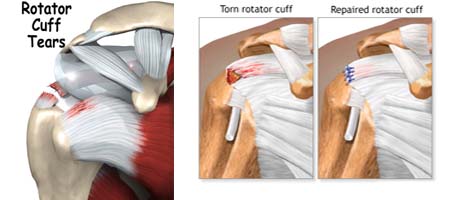Shoulder Anatomy
The shoulder complex is made up of three bones; the humerus, scapula and clavicle. Together thes form a ball and socket joint. Your shoulder is the most mobile joint in your body and is therefore dependent on strong muscles to move and stablise it. The most important muscles for this purpose are the rotator cuff muscles.
The rotator cuff is a group of muscles closely wrapped around the top of your arm(humerus). These muscles originate from your shoulder blade and their tendons form a hood covering the ball of your socket joint. These tendons can be damaged through general wear and tear, or after an accident/fall. If one or moreof these musclesare damaged, movement may becomedifficult and the shoulder becomes weak and painful.

Symptoms
The most common symptoms of a rotator cuff tear include :
- Pain at rest and at night, particularly if lying on the affected shoulder.
- Pain when lifting and lowering your arm or with specific movements.
- Weakness when lifting or rotating your arm.
- Crepitus or crackling sansation when moving your shoulder in certain positions.
Physical Examination
After discussion your symptoms and medical history, your doctor will examine your shoulder. He will check to see whether it is tender in any areaor whether there is a deformity and measure the range of motion of your shoulder.
Investigation
- X-Rays : Plain X-Ray of a shoulder with rotator cuff pain are usually normal.
- Magnetic resonance imaging(MRI) or Ultrasound: They can show the rotator cuff tear, as well as where the tear is located within the tendon and the size of the tear.

Treatment
The goal of any treatment is to reduce pain and restore function. There are several treatment option for a rotator cuff tear, and the best option is different for every person. In planning your treatment, your doctor will consider your age, activity level, general health and the type of tear you have.
Non Surgical treatment:
In about 50% of patients, non surgical treatment relieves pain and improves function in the shoulder. Shoulder strength, however, does not usually improve without surgery.
Non surgical treatment options may include:
- Rest: Rest and limiting overhead activities.
- Activity modification: Avoid activities that cause shoulder pain.
- Analgesic.
- Strengthening exercises and physical therapy: Specific exercises will restore movement and strengthen your shoulder.
Surgical Treatment
- Continued pain is the main indication for surgery.
- Your symptoms have lasted 6 to 12 months.
- You have a large tear(more than 3 cm.).
- You have significant weakness and loss of function in your shoulder.
- Your tear was caused by a recent, acute injury.
What is a rotator cuff repair ?

The operation aims to repair the damage and torn muscles or tendons. Once you are under a general anaesthetic the torn muscles are repaired using sutures or suture anchors depending on the type of damage. Often a ligament is also released and a piece of bone may be shaved or cut away to allow more space for the repaired muscle to heal.
The operation may be done arthroscopically(key hole surgery) or through an open incision. The type of approach used will be determined by the size and nature of the tear.
After the operation:
Your arm is supported in a sling straight after your operation to protect the repair. It is essential that you wear the sling day & night for 2-6 weeks. The amount of time will depend on the size of the rotator cuff tear. This will be explained to you after your surgery. You can remove the sling to carry out your exercises and for washing and dressing only.
Pain
It is normal to feel some pain following your operation. You will be given some pain killers and anti inflammatory medication. Using ice on your shoulder can be helpful in reducing pain.
Wound care
Your wound need to stay clean and dry. Stitches will be removed after 10-14 days.
Rehabilitation
Rehabilitation is important if you are to get the most out of your shoulder after the operation. The amount of physiotherapy you will need will depend on your individual progress and the level of activity you wish to return to.
Returning to work
The amount of time you have off work depends on your job. If you have a manual job, or one that involves lifting or overhead activities, you will not be able to do this for 8-12 weeks.
Sports and activities
The time scale for which you can go back to any previous sport or activity will depend on your movement and strength.
Important things to remember following rotator cuff repair
- Continue to wear your sling day and night.
- Do not lift your operated arm without assistance until it is allowed out of the sling.
- Do not use the unoperated arm for any heavy manual work whilst in the sling.
These are imortant to protect the repaired tendons.
Making a decision
Ask your doctor ,
- Advantages and disadvantages of non surgical or surgical treatments ?
- If I need surgery, which surgery(open , mini open or arthroscopic) do you think would be best for me ?
- How long do you think it will take me after treatment to return to my activities ?
- Will these treatments help my rotatorfcuff for many years ?
- When should I expect my pain and other symptoms to feel better ?